Comparative Analysis of Healthcare Funding Systems: Denmark and Canada
VerifiedAdded on 2022/10/11
|10
|2589
|15
Report
AI Summary
This report provides a comparative analysis of healthcare funding systems in Denmark and Canada. It explores the financing mechanisms, including public and private sources, and examines the implications of these systems on healthcare equity and efficiency. The report discusses the current healthcare funding system of Denmark, primarily financed through public funds and supplemented by private insurance, contrasting it with Canada's system, which involves both provincial and federal funding through taxation. It analyzes market failures such as adverse selection and moral hazards within the context of each country's healthcare model. Furthermore, the report delves into the management of perverse incentives, allocative and technical efficiency, and the advancement of healthcare equity. It also addresses challenges related to adverse selection and the need for improved information sharing. The conclusion highlights key differences in healthcare financing, the impact of public versus private insurance, and the importance of equity and accessibility within both systems.
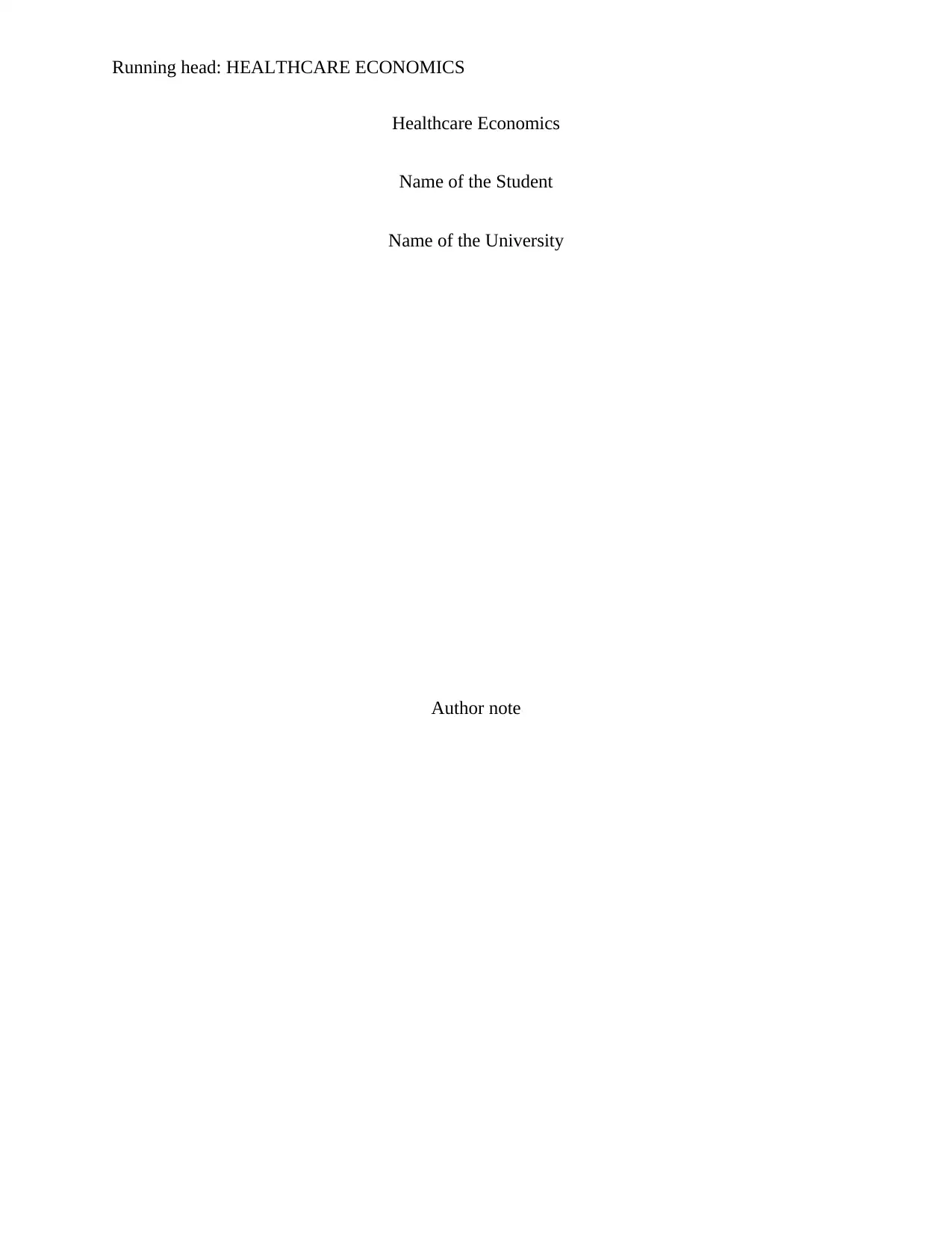
Running head: HEALTHCARE ECONOMICS
Healthcare Economics
Name of the Student
Name of the University
Author note
Healthcare Economics
Name of the Student
Name of the University
Author note
Paraphrase This Document
Need a fresh take? Get an instant paraphrase of this document with our AI Paraphraser
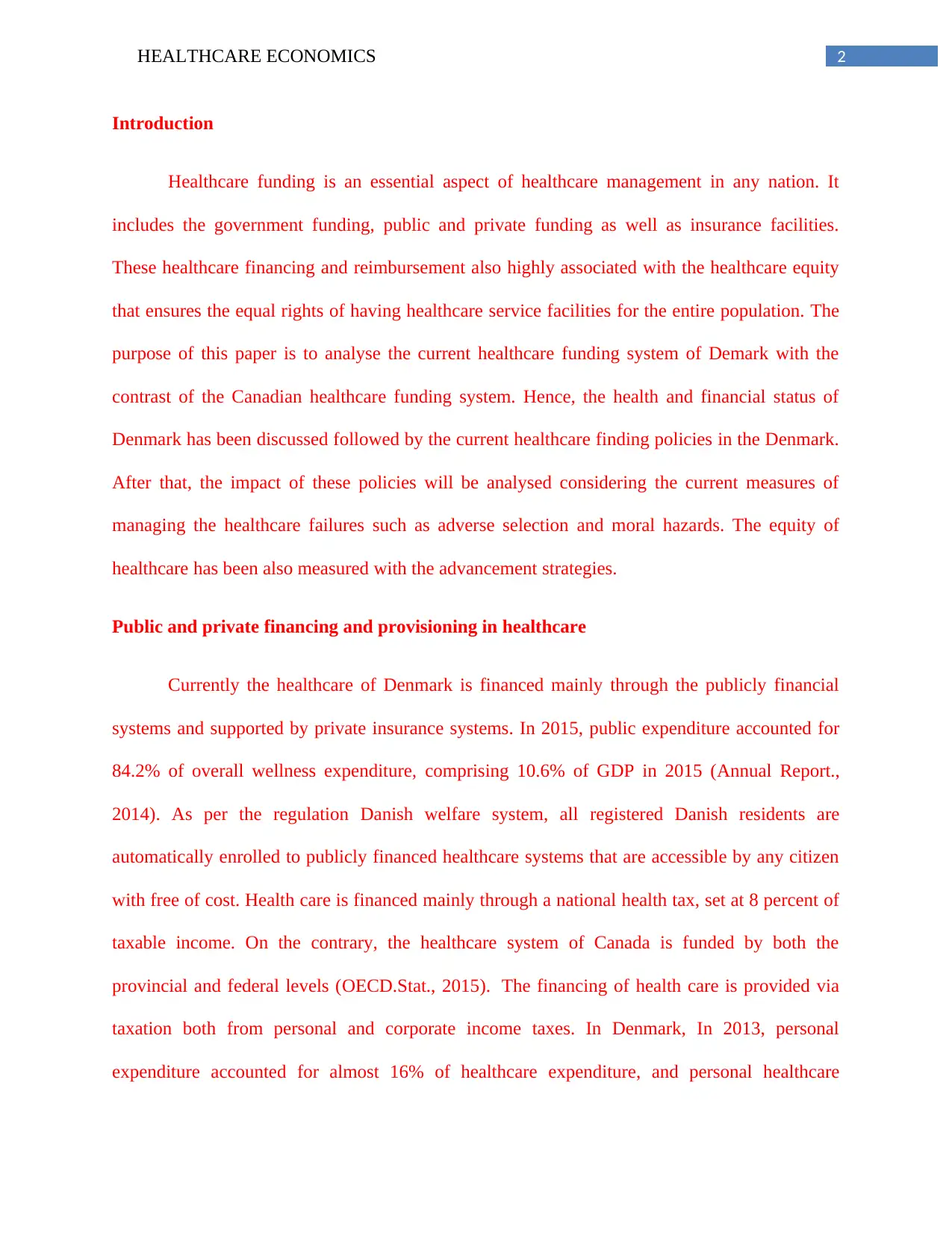
2HEALTHCARE ECONOMICS
Introduction
Healthcare funding is an essential aspect of healthcare management in any nation. It
includes the government funding, public and private funding as well as insurance facilities.
These healthcare financing and reimbursement also highly associated with the healthcare equity
that ensures the equal rights of having healthcare service facilities for the entire population. The
purpose of this paper is to analyse the current healthcare funding system of Demark with the
contrast of the Canadian healthcare funding system. Hence, the health and financial status of
Denmark has been discussed followed by the current healthcare finding policies in the Denmark.
After that, the impact of these policies will be analysed considering the current measures of
managing the healthcare failures such as adverse selection and moral hazards. The equity of
healthcare has been also measured with the advancement strategies.
Public and private financing and provisioning in healthcare
Currently the healthcare of Denmark is financed mainly through the publicly financial
systems and supported by private insurance systems. In 2015, public expenditure accounted for
84.2% of overall wellness expenditure, comprising 10.6% of GDP in 2015 (Annual Report.,
2014). As per the regulation Danish welfare system, all registered Danish residents are
automatically enrolled to publicly financed healthcare systems that are accessible by any citizen
with free of cost. Health care is financed mainly through a national health tax, set at 8 percent of
taxable income. On the contrary, the healthcare system of Canada is funded by both the
provincial and federal levels (OECD.Stat., 2015). The financing of health care is provided via
taxation both from personal and corporate income taxes. In Denmark, In 2013, personal
expenditure accounted for almost 16% of healthcare expenditure, and personal healthcare
Introduction
Healthcare funding is an essential aspect of healthcare management in any nation. It
includes the government funding, public and private funding as well as insurance facilities.
These healthcare financing and reimbursement also highly associated with the healthcare equity
that ensures the equal rights of having healthcare service facilities for the entire population. The
purpose of this paper is to analyse the current healthcare funding system of Demark with the
contrast of the Canadian healthcare funding system. Hence, the health and financial status of
Denmark has been discussed followed by the current healthcare finding policies in the Denmark.
After that, the impact of these policies will be analysed considering the current measures of
managing the healthcare failures such as adverse selection and moral hazards. The equity of
healthcare has been also measured with the advancement strategies.
Public and private financing and provisioning in healthcare
Currently the healthcare of Denmark is financed mainly through the publicly financial
systems and supported by private insurance systems. In 2015, public expenditure accounted for
84.2% of overall wellness expenditure, comprising 10.6% of GDP in 2015 (Annual Report.,
2014). As per the regulation Danish welfare system, all registered Danish residents are
automatically enrolled to publicly financed healthcare systems that are accessible by any citizen
with free of cost. Health care is financed mainly through a national health tax, set at 8 percent of
taxable income. On the contrary, the healthcare system of Canada is funded by both the
provincial and federal levels (OECD.Stat., 2015). The financing of health care is provided via
taxation both from personal and corporate income taxes. In Denmark, In 2013, personal
expenditure accounted for almost 16% of healthcare expenditure, and personal healthcare

3HEALTHCARE ECONOMICS
accounted for about 12% of complete personal expenditure (M. Olejaz, Juul Nielsen &
Rudkjøbing, 2014). However, in Canada Private health insurance schemes are typically provided
in many businesses as portion of employee benefit packages. Usually, incentives include sight
and dental care. Alternatively, private insurance companies can buy insurance plans from
Canadians. About three quarters of all financing comes from government outlets, while the rest
comes from personal outlets such as companies and private insurance (Canadian-healthcare.org,
2018).
Current cause of market failure
In healthcare economics, market failure occurs when the target consumers do not get
enough potential benefit from the healthcare financial support and provisions. At the same time,
it cal also lead to waste of funding and provisioning. The Danish healthcare system is universal,
which is based and the principle of free and equal access for all citizens. The quality and of the
Danish healthcare services are majorly financed by general taxes. Because of this free and equal
access the public service commission of Denmark does not have proper updated data about the
health and lifestyle of a large number of insurance holders. Life expectancy of Denmark has
increased from 78 years to 81 years within 2010 to 2015 (Diderichsen et al., 2016). Therefore the
number of potential market consumers has also increased significantly where the increasing
number of adverse selections and moral hazards can be found in current publicly funded health
insurances. On the contrary, Canada has more open healthcare funding policies where the people
have better opportunity to receive more continent and different types of health insurances. Lack
accounted for about 12% of complete personal expenditure (M. Olejaz, Juul Nielsen &
Rudkjøbing, 2014). However, in Canada Private health insurance schemes are typically provided
in many businesses as portion of employee benefit packages. Usually, incentives include sight
and dental care. Alternatively, private insurance companies can buy insurance plans from
Canadians. About three quarters of all financing comes from government outlets, while the rest
comes from personal outlets such as companies and private insurance (Canadian-healthcare.org,
2018).
Current cause of market failure
In healthcare economics, market failure occurs when the target consumers do not get
enough potential benefit from the healthcare financial support and provisions. At the same time,
it cal also lead to waste of funding and provisioning. The Danish healthcare system is universal,
which is based and the principle of free and equal access for all citizens. The quality and of the
Danish healthcare services are majorly financed by general taxes. Because of this free and equal
access the public service commission of Denmark does not have proper updated data about the
health and lifestyle of a large number of insurance holders. Life expectancy of Denmark has
increased from 78 years to 81 years within 2010 to 2015 (Diderichsen et al., 2016). Therefore the
number of potential market consumers has also increased significantly where the increasing
number of adverse selections and moral hazards can be found in current publicly funded health
insurances. On the contrary, Canada has more open healthcare funding policies where the people
have better opportunity to receive more continent and different types of health insurances. Lack
⊘ This is a preview!⊘
Do you want full access?
Subscribe today to unlock all pages.

Trusted by 1+ million students worldwide

4HEALTHCARE ECONOMICS
of private health insurance is reducing the holistic healthcare improvement that includes the
tertiary health status of the community as well (OECD.Stat., 2015). Apart from that, lack of
privatisation is restricting the potential growth of health education.
Managing perverse incentives
Perverse incentive implies the financial and provisional facilities funded by the
government or partially interfered by the public service authorities where governments try to set
prices and reimbursement rates. The Danish healthcare system is universal, which is based n the
principle of free and equal access for all citizens. Health care is financed mainly through a
national health tax, set at 8 percent of taxable income. The healthcare related revenues or funding
estimations are allocated to regions and municipalities, mostly as block grants, with amounts
adjusted for demographic and social differences; these grants finance 77 percent of regional
activities (OECD Health Statistics., 2019). Therefore, to manage this distributive and huge
number of perverse incentives the government of Denmark has to ensure some major principles
including a high quality of care; easy and equal access to care; choice of provisioning,
integration of service, keeping transparency, both sided access to information and short
weighting time to get service and provisional benefit. On the other hand, because of the better
exposure of the privatised healthcare funding, the Canadian government is not requiring to focus
on an alternate strategy to secure the quality of tertiary healthcare services (M. Olejaz, Juul
Nielsen & Rudkjøbing, 2014).
Allocative and Technical efficiency
In health economics the allocative efficiency refers to the point where the Marginal
Utility and Marginal Cost intersect because of the optimum distribution of resource allocation
of private health insurance is reducing the holistic healthcare improvement that includes the
tertiary health status of the community as well (OECD.Stat., 2015). Apart from that, lack of
privatisation is restricting the potential growth of health education.
Managing perverse incentives
Perverse incentive implies the financial and provisional facilities funded by the
government or partially interfered by the public service authorities where governments try to set
prices and reimbursement rates. The Danish healthcare system is universal, which is based n the
principle of free and equal access for all citizens. Health care is financed mainly through a
national health tax, set at 8 percent of taxable income. The healthcare related revenues or funding
estimations are allocated to regions and municipalities, mostly as block grants, with amounts
adjusted for demographic and social differences; these grants finance 77 percent of regional
activities (OECD Health Statistics., 2019). Therefore, to manage this distributive and huge
number of perverse incentives the government of Denmark has to ensure some major principles
including a high quality of care; easy and equal access to care; choice of provisioning,
integration of service, keeping transparency, both sided access to information and short
weighting time to get service and provisional benefit. On the other hand, because of the better
exposure of the privatised healthcare funding, the Canadian government is not requiring to focus
on an alternate strategy to secure the quality of tertiary healthcare services (M. Olejaz, Juul
Nielsen & Rudkjøbing, 2014).
Allocative and Technical efficiency
In health economics the allocative efficiency refers to the point where the Marginal
Utility and Marginal Cost intersect because of the optimum distribution of resource allocation
Paraphrase This Document
Need a fresh take? Get an instant paraphrase of this document with our AI Paraphraser

5HEALTHCARE ECONOMICS
while developing maximum potential consumer preference. The remaining 20 percent of
financing for regional services comes from municipal activity-based payments, which are
financed through a combination of local taxes and block grants (Burau et al., 2014). Currently
2.2 million Danes have either private organisation based coverage, which is provided almost
exclusively by the not-for-profit organization of Danmark (Regioner.dk., 2016). Therefore, it can
be clearly seen that a large number people of Denmark prefers private health insurance over the
Public funded facilities.
The technical efficiency refers to the efficiency measurement that gauge the ratio of
existing output and the input of potential output generation. Currently, the expenditure on
education and training corresponds to healthcare service is 7 per cent of the Denmark's GDP and
around 13 per cent of total public expenditure (Annual Report., 2014). In Canada, the regions
own, manage, and finance hospitals and finance the majority of services delivered by private
general practitioners (GPs), physiotherapists, office-based specialists, dentists, and pharmacists.
On the other hand, in Denmark Municipalities are accountable for funding and delivery of
nursing home care, house nurses, health care visitors, certain dental facilities, college social
facilities, house assistance and drug and liquor addiction therapy. This huge investment is also
receiving a satisfactory efficiency margin as well. The Life expectancy of Denmark has
increased from 78 years to 81 years within 2010 to 2015 (Diderichsen et al., 2016).
while developing maximum potential consumer preference. The remaining 20 percent of
financing for regional services comes from municipal activity-based payments, which are
financed through a combination of local taxes and block grants (Burau et al., 2014). Currently
2.2 million Danes have either private organisation based coverage, which is provided almost
exclusively by the not-for-profit organization of Danmark (Regioner.dk., 2016). Therefore, it can
be clearly seen that a large number people of Denmark prefers private health insurance over the
Public funded facilities.
The technical efficiency refers to the efficiency measurement that gauge the ratio of
existing output and the input of potential output generation. Currently, the expenditure on
education and training corresponds to healthcare service is 7 per cent of the Denmark's GDP and
around 13 per cent of total public expenditure (Annual Report., 2014). In Canada, the regions
own, manage, and finance hospitals and finance the majority of services delivered by private
general practitioners (GPs), physiotherapists, office-based specialists, dentists, and pharmacists.
On the other hand, in Denmark Municipalities are accountable for funding and delivery of
nursing home care, house nurses, health care visitors, certain dental facilities, college social
facilities, house assistance and drug and liquor addiction therapy. This huge investment is also
receiving a satisfactory efficiency margin as well. The Life expectancy of Denmark has
increased from 78 years to 81 years within 2010 to 2015 (Diderichsen et al., 2016).

6HEALTHCARE ECONOMICS
Parliament (Filketing)
Ministry for health and
provisions
Annual Global Budget
Public Health Medical
Authority
5
Major Regions
98
Municipalities
NGO and Private
Investment
Hospitals
GPs and
practicing
specialist
Healthcare
funding is an
essential aspect
of healthcare
management in
any nation. It
includes the
government
funding, public
and private
funding as well
as insurance
facilities. These
healthcare
financing and
reimbursement
also highly
associated with
the healthcare
equity that
ensures the
equal rights of
having
healthcare
service facilities
for the entire
population. The
purpose of this
paper is to
analyse the
current
healthcare
funding system
of Demark with
the contrast of
the Canadian
healthcare
Home Care,
Prevention,
rehabilitation
Figure: Structure of Health Funding Resource Allocation in Denmark
Source: (Burau et al., 2018; M. Olejaz, Juul Nielsen & Rudkjøbing (2014)
Advancing equity of healthcare
The healthcare service funding and provisional equity is one of the major health
competency standards. Both vertical and horizontal equity can be used to ensure equity in
healthcare funding. The healthcare system provided by the Denmark is based on vertical equity
that includes equally free access to primary healthcare service, out-of-pocket medical expenses
and others. However, there are some other aspects that could be focused to improve the health
Parliament (Filketing)
Ministry for health and
provisions
Annual Global Budget
Public Health Medical
Authority
5
Major Regions
98
Municipalities
NGO and Private
Investment
Hospitals
GPs and
practicing
specialist
Healthcare
funding is an
essential aspect
of healthcare
management in
any nation. It
includes the
government
funding, public
and private
funding as well
as insurance
facilities. These
healthcare
financing and
reimbursement
also highly
associated with
the healthcare
equity that
ensures the
equal rights of
having
healthcare
service facilities
for the entire
population. The
purpose of this
paper is to
analyse the
current
healthcare
funding system
of Demark with
the contrast of
the Canadian
healthcare
Home Care,
Prevention,
rehabilitation
Figure: Structure of Health Funding Resource Allocation in Denmark
Source: (Burau et al., 2018; M. Olejaz, Juul Nielsen & Rudkjøbing (2014)
Advancing equity of healthcare
The healthcare service funding and provisional equity is one of the major health
competency standards. Both vertical and horizontal equity can be used to ensure equity in
healthcare funding. The healthcare system provided by the Denmark is based on vertical equity
that includes equally free access to primary healthcare service, out-of-pocket medical expenses
and others. However, there are some other aspects that could be focused to improve the health
⊘ This is a preview!⊘
Do you want full access?
Subscribe today to unlock all pages.

Trusted by 1+ million students worldwide
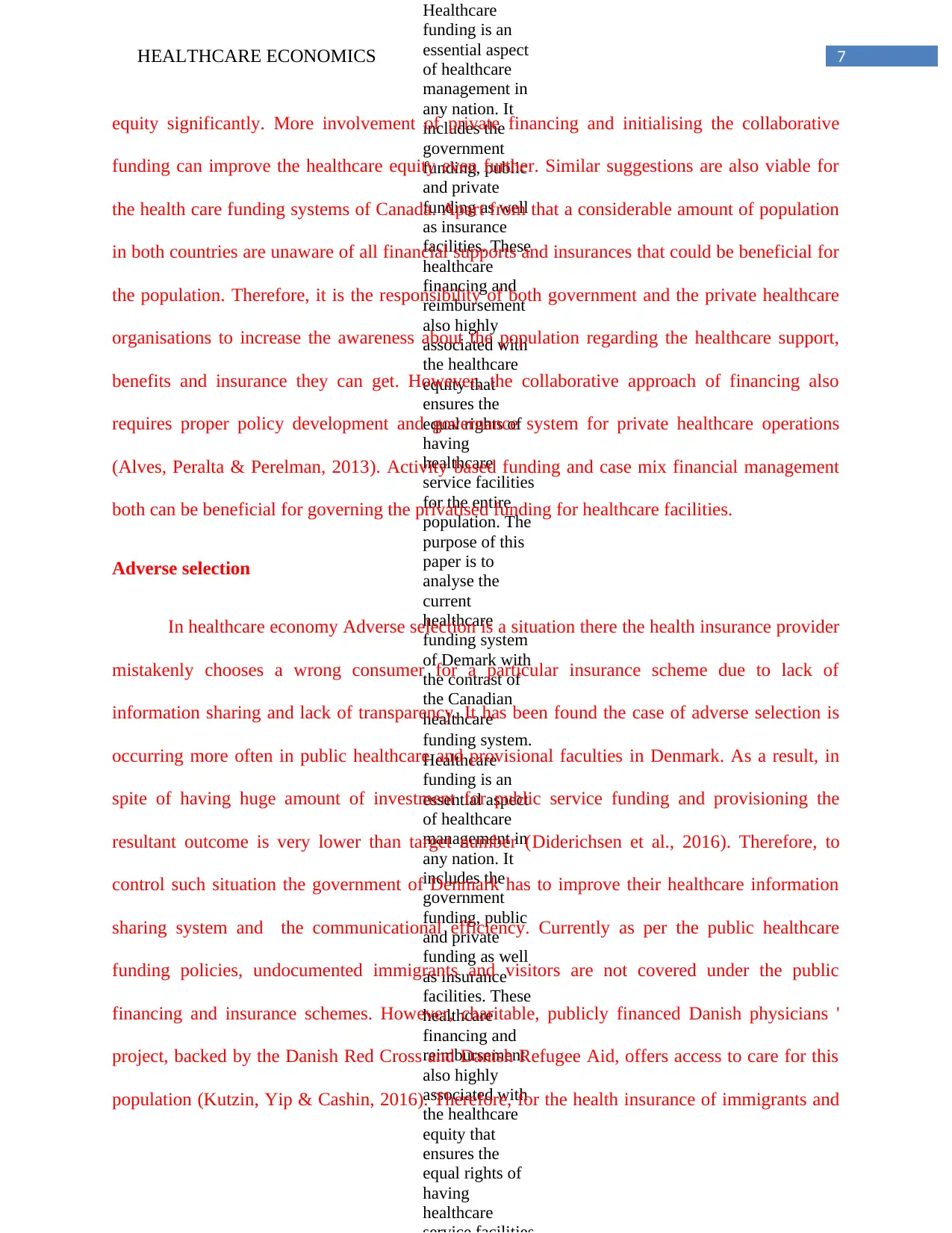
7HEALTHCARE ECONOMICS
Healthcare
funding is an
essential aspect
of healthcare
management in
any nation. It
includes the
government
funding, public
and private
funding as well
as insurance
facilities. These
healthcare
financing and
reimbursement
also highly
associated with
the healthcare
equity that
ensures the
equal rights of
having
healthcare
service facilities
for the entire
population. The
purpose of this
paper is to
analyse the
current
healthcare
funding system
of Demark with
the contrast of
the Canadian
healthcare
funding system.
Healthcare
funding is an
essential aspect
of healthcare
management in
any nation. It
includes the
government
funding, public
and private
funding as well
as insurance
facilities. These
healthcare
financing and
reimbursement
also highly
associated with
the healthcare
equity that
ensures the
equal rights of
having
healthcare
equity significantly. More involvement of private financing and initialising the collaborative
funding can improve the healthcare equity even further. Similar suggestions are also viable for
the health care funding systems of Canada. Apart from that a considerable amount of population
in both countries are unaware of all financial supports and insurances that could be beneficial for
the population. Therefore, it is the responsibility of both government and the private healthcare
organisations to increase the awareness about the population regarding the healthcare support,
benefits and insurance they can get. However, the collaborative approach of financing also
requires proper policy development and governance system for private healthcare operations
(Alves, Peralta & Perelman, 2013). Activity based funding and case mix financial management
both can be beneficial for governing the privatised funding for healthcare facilities.
Adverse selection
In healthcare economy Adverse selection is a situation there the health insurance provider
mistakenly chooses a wrong consumer for a particular insurance scheme due to lack of
information sharing and lack of transparency. It has been found the case of adverse selection is
occurring more often in public healthcare and provisional faculties in Denmark. As a result, in
spite of having huge amount of investment for public service funding and provisioning the
resultant outcome is very lower than target number (Diderichsen et al., 2016). Therefore, to
control such situation the government of Denmark has to improve their healthcare information
sharing system and the communicational efficiency. Currently as per the public healthcare
funding policies, undocumented immigrants and visitors are not covered under the public
financing and insurance schemes. However, charitable, publicly financed Danish physicians '
project, backed by the Danish Red Cross and Danish Refugee Aid, offers access to care for this
population (Kutzin, Yip & Cashin, 2016). Therefore, for the health insurance of immigrants and
Healthcare
funding is an
essential aspect
of healthcare
management in
any nation. It
includes the
government
funding, public
and private
funding as well
as insurance
facilities. These
healthcare
financing and
reimbursement
also highly
associated with
the healthcare
equity that
ensures the
equal rights of
having
healthcare
service facilities
for the entire
population. The
purpose of this
paper is to
analyse the
current
healthcare
funding system
of Demark with
the contrast of
the Canadian
healthcare
funding system.
Healthcare
funding is an
essential aspect
of healthcare
management in
any nation. It
includes the
government
funding, public
and private
funding as well
as insurance
facilities. These
healthcare
financing and
reimbursement
also highly
associated with
the healthcare
equity that
ensures the
equal rights of
having
healthcare
equity significantly. More involvement of private financing and initialising the collaborative
funding can improve the healthcare equity even further. Similar suggestions are also viable for
the health care funding systems of Canada. Apart from that a considerable amount of population
in both countries are unaware of all financial supports and insurances that could be beneficial for
the population. Therefore, it is the responsibility of both government and the private healthcare
organisations to increase the awareness about the population regarding the healthcare support,
benefits and insurance they can get. However, the collaborative approach of financing also
requires proper policy development and governance system for private healthcare operations
(Alves, Peralta & Perelman, 2013). Activity based funding and case mix financial management
both can be beneficial for governing the privatised funding for healthcare facilities.
Adverse selection
In healthcare economy Adverse selection is a situation there the health insurance provider
mistakenly chooses a wrong consumer for a particular insurance scheme due to lack of
information sharing and lack of transparency. It has been found the case of adverse selection is
occurring more often in public healthcare and provisional faculties in Denmark. As a result, in
spite of having huge amount of investment for public service funding and provisioning the
resultant outcome is very lower than target number (Diderichsen et al., 2016). Therefore, to
control such situation the government of Denmark has to improve their healthcare information
sharing system and the communicational efficiency. Currently as per the public healthcare
funding policies, undocumented immigrants and visitors are not covered under the public
financing and insurance schemes. However, charitable, publicly financed Danish physicians '
project, backed by the Danish Red Cross and Danish Refugee Aid, offers access to care for this
population (Kutzin, Yip & Cashin, 2016). Therefore, for the health insurance of immigrants and
Paraphrase This Document
Need a fresh take? Get an instant paraphrase of this document with our AI Paraphraser
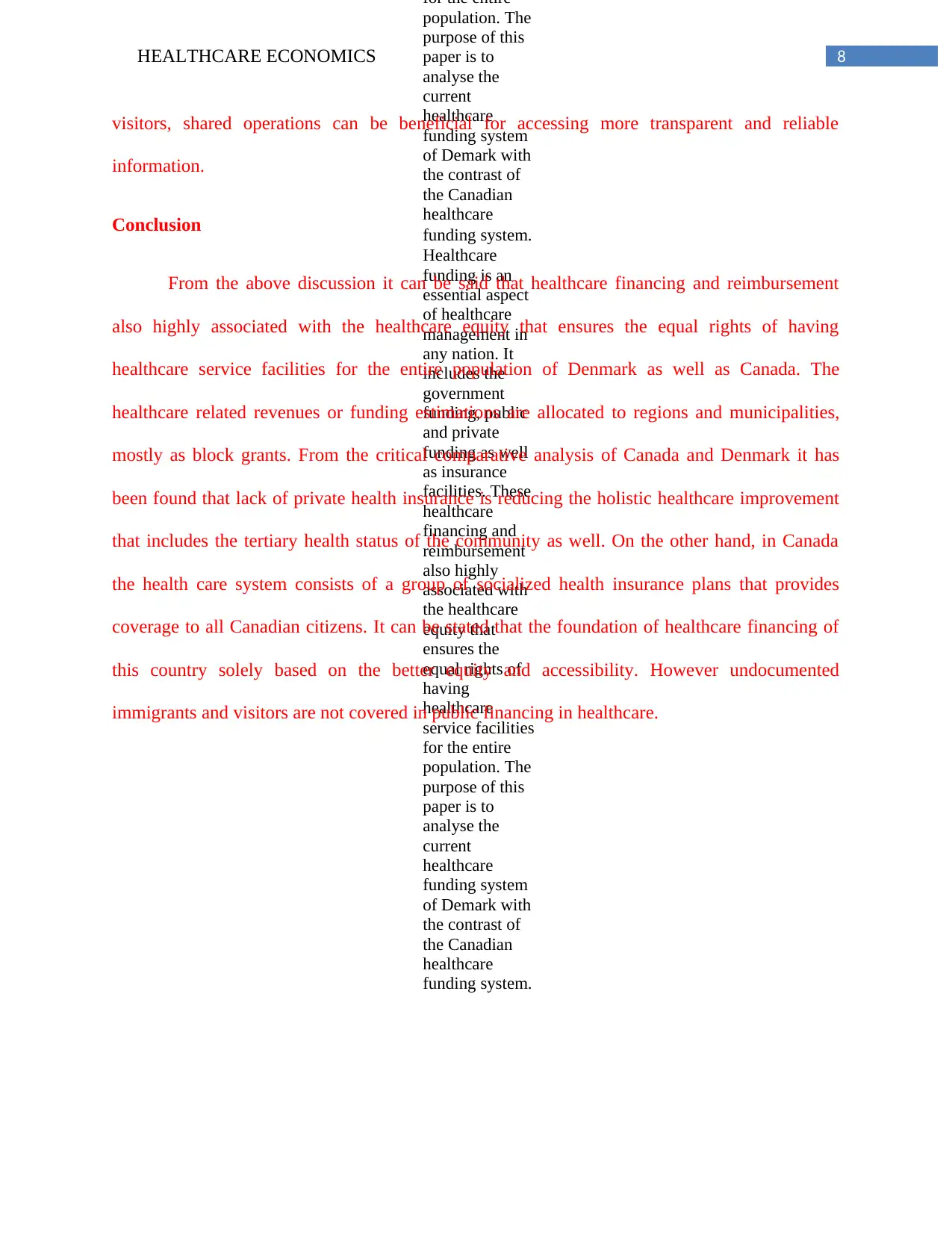
8HEALTHCARE ECONOMICS
for the entire
population. The
purpose of this
paper is to
analyse the
current
healthcare
funding system
of Demark with
the contrast of
the Canadian
healthcare
funding system.
Healthcare
funding is an
essential aspect
of healthcare
management in
any nation. It
includes the
government
funding, public
and private
funding as well
as insurance
facilities. These
healthcare
financing and
reimbursement
also highly
associated with
the healthcare
equity that
ensures the
equal rights of
having
healthcare
service facilities
for the entire
population. The
purpose of this
paper is to
analyse the
current
healthcare
funding system
of Demark with
the contrast of
the Canadian
healthcare
funding system.
visitors, shared operations can be beneficial for accessing more transparent and reliable
information.
Conclusion
From the above discussion it can be said that healthcare financing and reimbursement
also highly associated with the healthcare equity that ensures the equal rights of having
healthcare service facilities for the entire population of Denmark as well as Canada. The
healthcare related revenues or funding estimations are allocated to regions and municipalities,
mostly as block grants. From the critical comparative analysis of Canada and Denmark it has
been found that lack of private health insurance is reducing the holistic healthcare improvement
that includes the tertiary health status of the community as well. On the other hand, in Canada
the health care system consists of a group of socialized health insurance plans that provides
coverage to all Canadian citizens. It can be stated that the foundation of healthcare financing of
this country solely based on the better equity and accessibility. However undocumented
immigrants and visitors are not covered in public financing in healthcare.
for the entire
population. The
purpose of this
paper is to
analyse the
current
healthcare
funding system
of Demark with
the contrast of
the Canadian
healthcare
funding system.
Healthcare
funding is an
essential aspect
of healthcare
management in
any nation. It
includes the
government
funding, public
and private
funding as well
as insurance
facilities. These
healthcare
financing and
reimbursement
also highly
associated with
the healthcare
equity that
ensures the
equal rights of
having
healthcare
service facilities
for the entire
population. The
purpose of this
paper is to
analyse the
current
healthcare
funding system
of Demark with
the contrast of
the Canadian
healthcare
funding system.
visitors, shared operations can be beneficial for accessing more transparent and reliable
information.
Conclusion
From the above discussion it can be said that healthcare financing and reimbursement
also highly associated with the healthcare equity that ensures the equal rights of having
healthcare service facilities for the entire population of Denmark as well as Canada. The
healthcare related revenues or funding estimations are allocated to regions and municipalities,
mostly as block grants. From the critical comparative analysis of Canada and Denmark it has
been found that lack of private health insurance is reducing the holistic healthcare improvement
that includes the tertiary health status of the community as well. On the other hand, in Canada
the health care system consists of a group of socialized health insurance plans that provides
coverage to all Canadian citizens. It can be stated that the foundation of healthcare financing of
this country solely based on the better equity and accessibility. However undocumented
immigrants and visitors are not covered in public financing in healthcare.
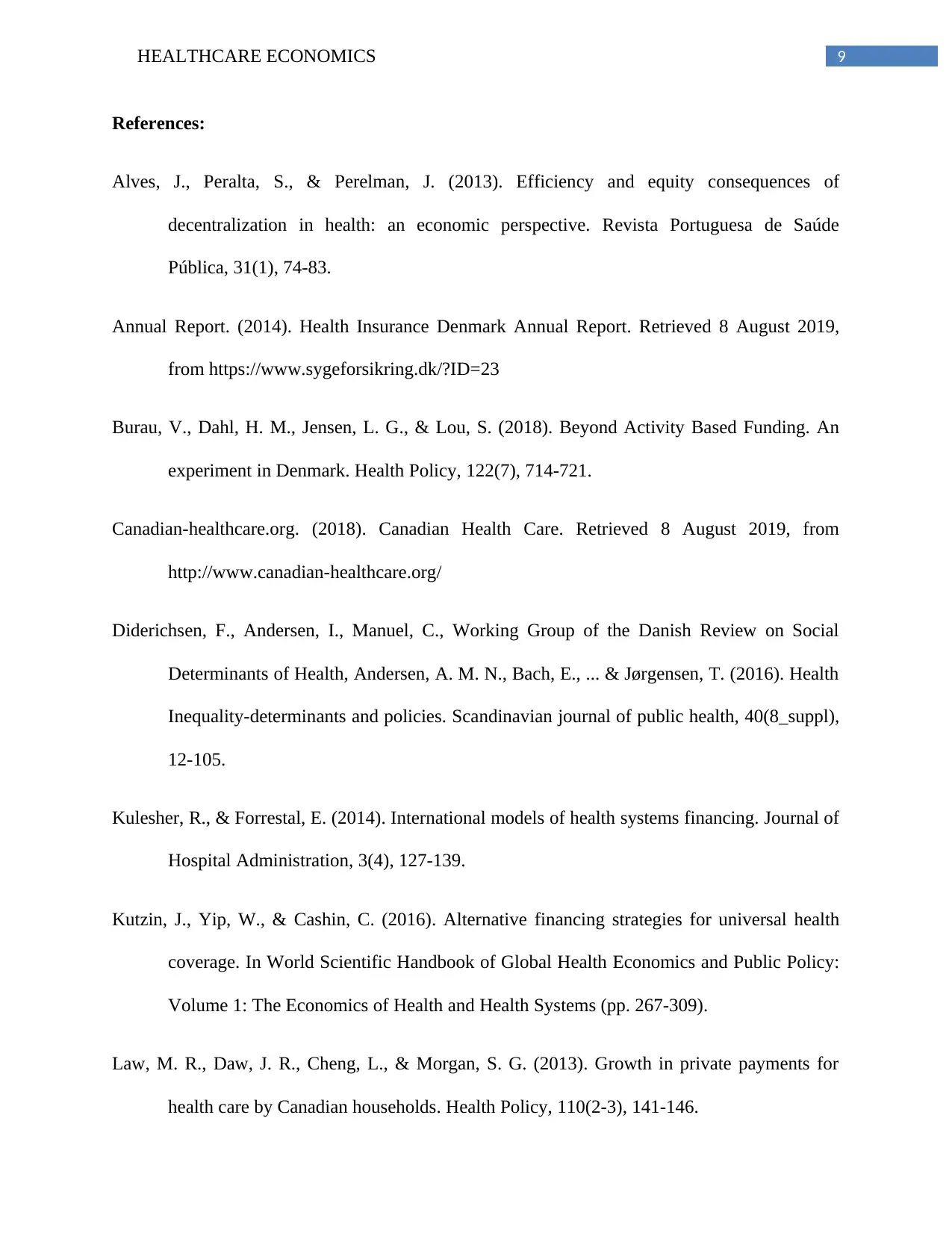
9HEALTHCARE ECONOMICS
References:
Alves, J., Peralta, S., & Perelman, J. (2013). Efficiency and equity consequences of
decentralization in health: an economic perspective. Revista Portuguesa de Saúde
Pública, 31(1), 74-83.
Annual Report. (2014). Health Insurance Denmark Annual Report. Retrieved 8 August 2019,
from https://www.sygeforsikring.dk/?ID=23
Burau, V., Dahl, H. M., Jensen, L. G., & Lou, S. (2018). Beyond Activity Based Funding. An
experiment in Denmark. Health Policy, 122(7), 714-721.
Canadian-healthcare.org. (2018). Canadian Health Care. Retrieved 8 August 2019, from
http://www.canadian-healthcare.org/
Diderichsen, F., Andersen, I., Manuel, C., Working Group of the Danish Review on Social
Determinants of Health, Andersen, A. M. N., Bach, E., ... & Jørgensen, T. (2016). Health
Inequality-determinants and policies. Scandinavian journal of public health, 40(8_suppl),
12-105.
Kulesher, R., & Forrestal, E. (2014). International models of health systems financing. Journal of
Hospital Administration, 3(4), 127-139.
Kutzin, J., Yip, W., & Cashin, C. (2016). Alternative financing strategies for universal health
coverage. In World Scientific Handbook of Global Health Economics and Public Policy:
Volume 1: The Economics of Health and Health Systems (pp. 267-309).
Law, M. R., Daw, J. R., Cheng, L., & Morgan, S. G. (2013). Growth in private payments for
health care by Canadian households. Health Policy, 110(2-3), 141-146.
References:
Alves, J., Peralta, S., & Perelman, J. (2013). Efficiency and equity consequences of
decentralization in health: an economic perspective. Revista Portuguesa de Saúde
Pública, 31(1), 74-83.
Annual Report. (2014). Health Insurance Denmark Annual Report. Retrieved 8 August 2019,
from https://www.sygeforsikring.dk/?ID=23
Burau, V., Dahl, H. M., Jensen, L. G., & Lou, S. (2018). Beyond Activity Based Funding. An
experiment in Denmark. Health Policy, 122(7), 714-721.
Canadian-healthcare.org. (2018). Canadian Health Care. Retrieved 8 August 2019, from
http://www.canadian-healthcare.org/
Diderichsen, F., Andersen, I., Manuel, C., Working Group of the Danish Review on Social
Determinants of Health, Andersen, A. M. N., Bach, E., ... & Jørgensen, T. (2016). Health
Inequality-determinants and policies. Scandinavian journal of public health, 40(8_suppl),
12-105.
Kulesher, R., & Forrestal, E. (2014). International models of health systems financing. Journal of
Hospital Administration, 3(4), 127-139.
Kutzin, J., Yip, W., & Cashin, C. (2016). Alternative financing strategies for universal health
coverage. In World Scientific Handbook of Global Health Economics and Public Policy:
Volume 1: The Economics of Health and Health Systems (pp. 267-309).
Law, M. R., Daw, J. R., Cheng, L., & Morgan, S. G. (2013). Growth in private payments for
health care by Canadian households. Health Policy, 110(2-3), 141-146.
⊘ This is a preview!⊘
Do you want full access?
Subscribe today to unlock all pages.

Trusted by 1+ million students worldwide
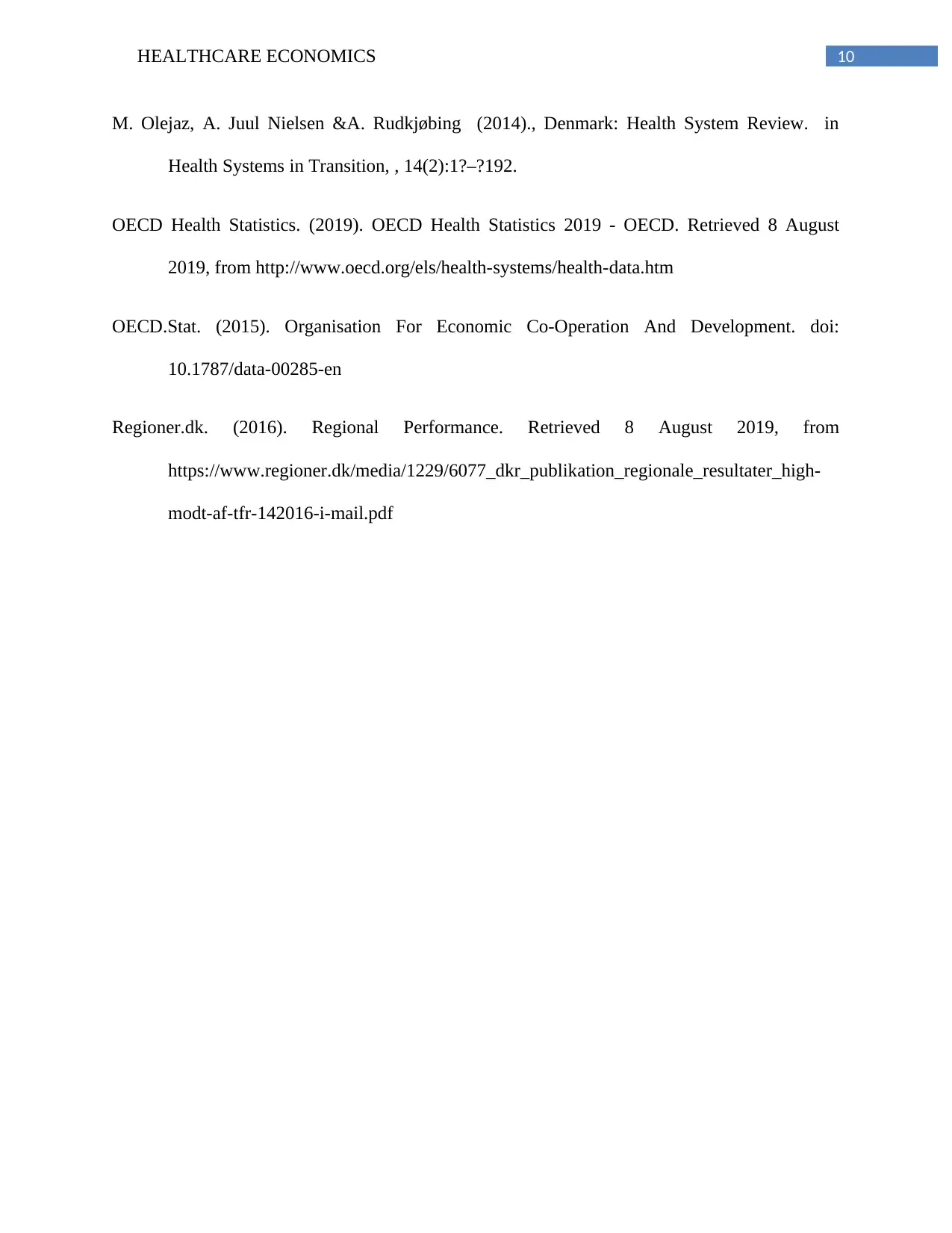
10HEALTHCARE ECONOMICS
M. Olejaz, A. Juul Nielsen &A. Rudkjøbing (2014)., Denmark: Health System Review. in
Health Systems in Transition, , 14(2):1?–?192.
OECD Health Statistics. (2019). OECD Health Statistics 2019 - OECD. Retrieved 8 August
2019, from http://www.oecd.org/els/health-systems/health-data.htm
OECD.Stat. (2015). Organisation For Economic Co-Operation And Development. doi:
10.1787/data-00285-en
Regioner.dk. (2016). Regional Performance. Retrieved 8 August 2019, from
https://www.regioner.dk/media/1229/6077_dkr_publikation_regionale_resultater_high-
modt-af-tfr-142016-i-mail.pdf
M. Olejaz, A. Juul Nielsen &A. Rudkjøbing (2014)., Denmark: Health System Review. in
Health Systems in Transition, , 14(2):1?–?192.
OECD Health Statistics. (2019). OECD Health Statistics 2019 - OECD. Retrieved 8 August
2019, from http://www.oecd.org/els/health-systems/health-data.htm
OECD.Stat. (2015). Organisation For Economic Co-Operation And Development. doi:
10.1787/data-00285-en
Regioner.dk. (2016). Regional Performance. Retrieved 8 August 2019, from
https://www.regioner.dk/media/1229/6077_dkr_publikation_regionale_resultater_high-
modt-af-tfr-142016-i-mail.pdf
1 out of 10
Related Documents
Your All-in-One AI-Powered Toolkit for Academic Success.
+13062052269
info@desklib.com
Available 24*7 on WhatsApp / Email
![[object Object]](/_next/static/media/star-bottom.7253800d.svg)
Unlock your academic potential
Copyright © 2020–2025 A2Z Services. All Rights Reserved. Developed and managed by ZUCOL.





